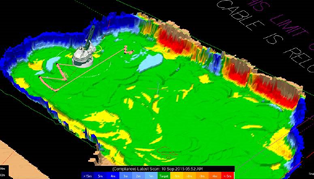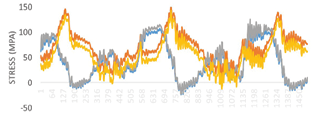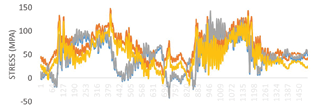Furthermore, as autonomous haulage deployments become more commonplace, the variation in performance between machine operators on loading equipment will continue to significantly affect the success factor for the whole load-and-haul process in the pit.
Primary loading tools, such as draglines, shovels and excavators, start the material movement process. The performance of these tools heavily influences the success of the downstream mining processes. Inefficiencies on the front end have dramatic repercussions to the overall value stream. As such, the loading equipment operator at the front end has significant influence on the overall cost of mining.
The three key dimensions to loader productivity under the operators’ control are payload compliance, mine plan compliance and machine damage management. Providing accurate, real-time information and easy-to-use technology empowers an operator to address all of these dimensions throughout each and every shift.
Operator awareness in real-time generates tangible productivity gains. Getting the operator actionable information in a timely fashion is the key to driving operator behavior thus improving decision making. Production reports for the last month, the last week, the last shift, or even the last few hours provide dated information. If it’s not known now, it’s too late to be fixed later.
The simple green fill-bar graphic on the right of the operator screen gives the operator all the information they need to control the haul truck’s payload.
Payload Compliance
Payload compliance involves both the rate and accuracy of the truck loading process. Keeping the operator informed in real time “tightens the bell curve” for truck payload distribution, which leads to an average increase and consistency in truck payload. Significant production and maintenance benefits are achieved by ensuring each and every truck is neither over nor under loaded.
Traditional payload measurements on trucks offer minimal accuracy until the truck leaves the loading zone. Getting the information after the truck leaves provides little, if any, value to loading equipment operators as they shift focus to the next truck. Real time payload information allows the operator to adjust the load while it still makes a difference, ensuring improvement in consistency. Providing real-time, accurate feedback, the operator can confidently adjust the critical last pass to ensure that each truck leaves with as close as possible to 100% of its nominal payload.
The challenges involved in maintaining accurately calibrated truck weighing systems, particularly for large fleets, and the significant fluctuations in the accuracy of strut-based payload weight measurement systems as a truck is being loaded, means a loader-based system is the only way available to achieve the desired objective.
The MineWare system is a reliable, accurate, low maintenance, loading tool-based payload calculation system that:
• Delivers a consistent, real-time 3% bucket payload accuracy;
• Requires minimal recalibration (less than once per year); and
• Provides significantly more benefits than traditional strut-
based truck payload systems.
Acquiring and maintaining operator acceptance and involvement (creating the “need” to use a system) is the third pillar of successful change management and, as such, a requirement for sustainable success for any technology deployment. Clear, timely and easy-to-interpret feedback influences operator behavior.
MineWare system deployments provide simple, clear feedback on the remaining payload to fill the truck currently being loaded. This is the core, primary mechanism through which payload optimization is achieved. It also informs the operators of their overall loading performance throughout the shift to track improvements over time. The system also compares each operator’s loading performance to all other operators, by operator and by machine to provide peer-based benchmarking and to identify those needing additional training.
On each in-cab display, a simple green fill-bar graphic provides the operators with all the information they need to control their truck payload. KPI bars along the bottom and side drives a “keep it in the green” behavior for increasing consistency and minimizing variation between operators. This intuitive design has yielded documented improvements in average truck payloads of more than 5%.

Real-time operator feedback for an excavator and dragline. Note how easily an operator and supervisor can quickly assess how well they are digging to plan.
Mine Plan Compliance
Mine plan compliance is ensuring the material excavated and loaded matches the mine’s plan. To ensure compliance with plan, loading machine operators must be provided with real-time, intuitive information that allows them to stay on track and avoid wasted effort and cleanup work. Intuitive real-time displays help an operator avoid an issue before it has the chance to occur. All the effort in getting maximum productivity out of a loading unit is worthless if all they are doing is loading the incorrect material.
MineWare provides operators with real-time, 3-D, color-coded feedback on where they are digging compared to where they are meant to dig. This critical information is available both on the loader in real time, and back in the office where engineering and supervisory staff can quickly assess the progress of the excavation. Alternative technologies such as UAVs and terrestrial scanners can provide quality data for detecting mine plan deviations, but the real-time nature of generating profiles on the loader allows the operator to avoid such deviations before they occur.
Significant reductions in deviations from the plan have been achieved through the system’s clear, concise and real-time operator feedback. With the 3-D displays, an operator and supervisor can quickly assess how well they are digging to plan.
Now the operator is loading quickly, accurately and is taking the right material. The next consideration is to minimize machine damage so as to maximize availability.

Stress data from two different operators on the same day, with the same conditions and the same production rate.

Machine Damage Management
Minimal benefit can be gained by increasing loading tool productivity if it results in increased maintenance costs and corresponding downtime. However, with the right monitoring system, loader productivity can be maximized without compromising the goal of minimizing machine damage. Smooth, competent loader operation can and does outperform rough operation, which yields higher production rates and significantly less machine damage.
Potential machine damage is a function of equipment vibration. By analyzing vibration and providing operators the key metrics, in real time, machine damage can be minimized.
If one tries to break a piece of fencing wire by pulling on each end, it will take considerable time and strength. However, if the same piece of fencing wire is bent back and forth the desired objective can be achieved with a lot less effort.
A loading machine is no different. Continual loading, unloading, and vibration take their toll on the machine and all its components. In fact, a doubling in machine load can equate to an up to eightfold increase in damage done. MineWare records real-time strain gauge data on loading equipment and focus on the cumulative impact of load and vibration in measuring machine damage. Small reductions in vibration equate to significant savings in component life.
The MineWare system displays each operator’s rate of damage to the machine as they are operating and contrasts that with the average levels for the machine. Historical information demonstrates that variations between operators are common.
Minimizing the variation in operator performance will improve overall machine availability. Involving the operators by keeping them informed, helps them evolve their loading techniques and attitudes to smooth the operation and increase overall productivity and minimizes its effect on machine availability. This is a principal success factor for the system.
It is often said that the most important person on a mine site with respect to productivity is not the mine manager, not the engineer, not the supervisor, but it is the humble machine operator.
If operator behavior can be changed and improvements realized in the three dimensions of loading tool performance: payload compliance, mine plan compliance, and machine damage management, then reporting and analysis will be more of a “check and balance” rather than a means to an end.
MineWare has demonstrated the ability to implement the behavioral changes necessary to ensure both payload and mine plan compliance, and still minimize machine damage. This proven value proposition makes the deployment of the system extremely compelling for any property interested in significantly improving productivity, availability and compliance with plan.
MineWare Pty Ltd. founder and CEO Andrew Jessett established MineWare in 2005 after independently creating and commercializing the world’s most advanced dragline monitoring system, the Pegasys Dragline Monitor. Today, Jessett continues to drive MineWare’s growth and development in delivering sophisticated dragline and shovel monitoring technologies.

